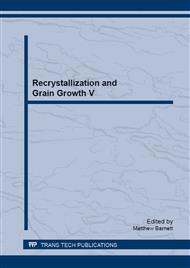p.243
p.247
p.251
p.257
p.263
p.267
p.271
p.275
p.279
Microstructural Evolution of AA6082 with Small Aluminides under Hot Torsion and Friction Stir Processing
Abstract:
The hot rolled AA6082 aluminium alloy with aluminide dispersoids is deformed up to large strains to obtain a fine grained microstructure. Friction stir spot welding (FSSW) is carried out on rolled plates by means of a device provided by MTS System Corporation. FEM simulations determine that the material can flow up to local strains between 10 and 50 when the material reaches temperatures between 300-500°C. With this information, hot torsion tests at constant temperatures are carried out in a Gleeble ® 3800 machine for different strain rates. In both cases, in situ water quenching is applied to freeze the microstructure and avoid any static recrystallization effect after hot deformation. Light optical microscopy is used to identify the evolution of the grains as a function of the local deformation parameters determined by FEM simulations. The microstructure development by FSSW as well as by torsion is then further characterized by means of EBSD. At small strains the material deforms mainly by dynamic recovery with small low angle grain boundary formation and boundary dragging by fine aluminides and Mg2Si. At large strains grain refinement by continuous dynamic recrystallization takes place heterogeneously as a function of the original crystallographic orientation and precipitation state of each grain.
Info:
Periodical:
Pages:
263-266
Citation:
Online since:
March 2013
Price:
Сopyright:
© 2013 Trans Tech Publications Ltd. All Rights Reserved
Share:
Citation:


